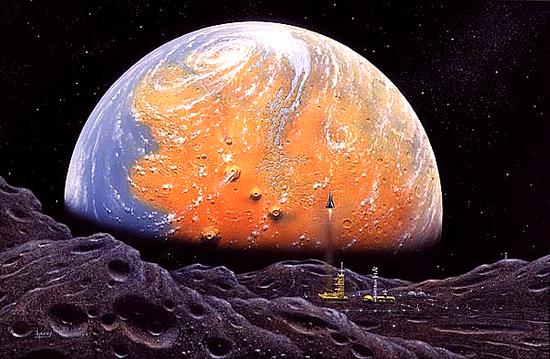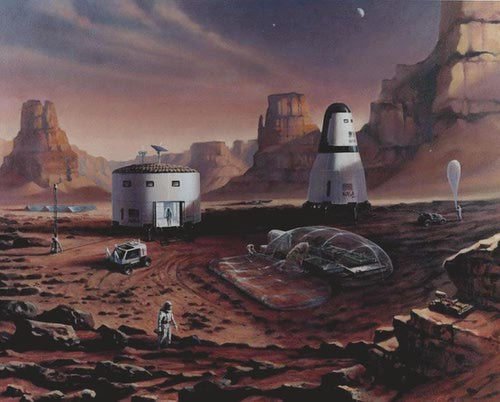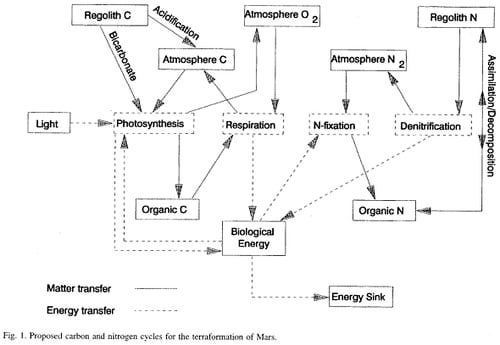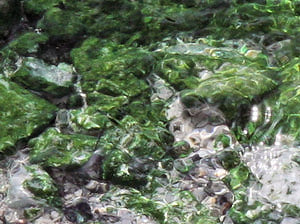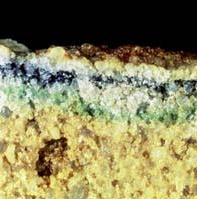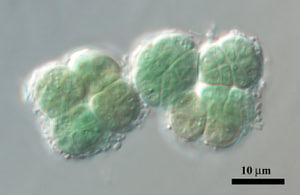Terraforming
Planetary Engineering
Terraforming or “Planetary Ecosynthesis” is the process of changing a planet’s atmosphere to resemble that of the Earth’s, with the goal of sustaining terrestrial life. It is predicted that establishment of life will be similar to Earth’s history, starting with basic unicellular microorganisms. The most feasible pioneer to begin life on a new planet would be some kind of photosynthetic microbe.[8]
The strategy of using photosynthesis to engineer a habitable planet for humans through photosynthesis would not be unlike the Great Ogygenation Event that took place on Earth 2.4 billion years ago, sometime after cyanobacteria first evolved (2.7-2.8 billion years ago.) This pivotal event paved the way for evolution of multi-cellular organisms and later, human beings.[4]
The topic has sprung much speculation as well as the ethical debates surrounding the idea, including the impacts on already exsisting life on Mars.
Candidates for Terraformation
Mars
Mars is the preferred planet of interest for terraforming because it contains a lot of CO2, nitrogen, and H2O.[8] Currently Mars is very cold (on average 220 degrees K, roughly -63.7 degrees F.) and its atmosphere is relatively thin and mostly consists of CO2 (95.3%) with very little O2 and N2. Mars only receives 43% of the light Earth gets from the Sun, yet it is still sufficient enough for photosynthesis.[10]
Proposed Terraformation of Mars would require:
- Warming the planet substantially to 290 K [1]
- Increase atmospheric pressure from 6 mbar to atleast 61.8 mbar which is required for people to live in, 10 mbar is required for plant life [1]
- Adding O2, about 240 mbar of oxygen would be comfortable for humans[1]
- Melt water (which Mars has frozen in Ice caps)[1]
- Cooling the planet substantially [2]
- Removing CO2 and other poisonous gases from the atmosphere while replacing it with O2 [2]
- Reduce day length to 24 hours [2]
- Provide water [2]
- the release of man-made and/or microbial greenhouse gases into the atmosphere, heating the planet substantially, [8]
- Initial warming will then cause CO2 evaporation from the planet’s own glaciers and soil, producing further warming. [8]
- Melting glaciers will produce hydrologic cycles and evaporated H2O into the air, creating a denser atmosphere. This suggests a global temperature of at least 0 degrees Celsius. .[8]
- Water will be stable on the surface and temperatures will be more moderate, but the atmosphere will be mostly CO2 and have little O2. .[8] So long as UV radiation remains high, microorganisms will be confined to living in or under rocks.[5]
- Must be photoautotrophs
- Must be anaerobic and respire without O2
- Osmotic tolerance
- Resistance to UV radiation
- Cold tolerance
- Tolerance for Nutrient limitations
- Tolerance for water limitations
- Resistance to oxides
- Adaptation to lowered intracellular pH due to CO2 in atmosphere
- Can form Endospores
Venus
Venus has been proposed but it’s problems far surpass Mars in that it has a very thick atmosphere, little water, no hydrogen, and it’s temperatures are much warmer than Earth around 730 K. The removal of atmospheric gas would be very difficult.[11] Venus also has clouds made of searing sulfuric acid, and one Venus day is equivalent to 127 Earth days.[2]
Proposed Terraformation of Venus would require:
Biological interaction
The interaction of pioneering microbial species within an alien atmosphere will hopefully pave the way for future organisms such as plants and eventually humans to be able to colonize that planet.
The primary function of photosynthetic pioneers would be to take CO2 out of the atmosphere while adding O2 to the atmosphere.[10]
Microbes could also be utilized to add greenhouse gases to the atmosphere through anaerobic respiration, as well as contribute to soil fertility simply by producing (and becoming) organic matter.
Niche: A New World
To lay the foundation of microbial terraforming on Mars, requirments include:
UV radiation screens have been proposed for microbial access to surfaces.[8]
Microbial populations set to colonize Mars can expect extreme cold temperatures, high radiation, little to no moisture, and limited nutrients. [8]
Microbial processes
Mars has no tectonic activity and thus no chemical turnover occurs there. It's thought that biological and photochemical processes can run some kind of biogeochemicalcycles on Mars.[10]
Carbon cycling
Photosynthetic microorganisms remove CO2 from the atmosphere by photosynthesis:
6CO2 + 12H2O + Light -> C6H12O6 + 6O2+ 6H2O
Eventually heterotrophic microbes will release CO2 back into the atmosphere through respiration:
C6H12O6 + 6O2 --> 6CO2 + 6H2O + energy
Certain Microorganisms such as Matteia have been proposed to release CO2 from carbonate rock to complete the cycle in the early stages of colonization, just until enough carbohydrate is available to support heterotrophs.[6]
Oxygen
Cyanobacteria and algae will be used to increase O2 through photosynthesis.
6CO2 + 12H2O + Light -> C6H12O6 + 6O2+ 6H2O
Nitrogen cycling
Besides CO2 and O2, a buffer gas is needed to support human life, and nitrogen is necessary for photosynthesis at the start of terraformation.
Currently there is not enough N2 in Mars' atmosphere for nitrogen fixation and therefore, denitrification is necessary as long as the regolith contains nitrate as is proposed.[1]
Denitrification:
NO3− → NO2− → NO + N2O → N2 (g)
Cyanobacteria and other Nitrogen fixers can reduce N2 to ammonia:
N2 + 8 H+ + 8 e− → 2 NH3 + H2
Methanogenesis
Methanogenesis is a an anaerobic process. Archaeal methanogens can utilize CO2 for production of methane which is 20x better at trapping heat than CO2. Methane gas also has the potential of being a fuel source.[14]
CO2 + 4 H2 → CH4 + 2H2O
Sulfur cycling
Most microbes utilize oxidized sulfur for protein synthesis.
Phosphorous cycling
Phosphates are insoluble minerals that are highly conserved in stable environments but through time losses can be a possible issue for terraformation. This may be the case with other non-volatile, minerals such as iron, manganese, and magnesium.[10]
Key Microorganisms
Microorganisms are the best option for colonization of a new planet because of their wide range of physiologic and metabolic functions, as well as their ability to conduct horizontal gene transfer. Two strategies have been proposed for choosing the best pioneers. One can either choose a generalist extremophile on Earth that inhabits environments similar to the new planet, or genetically modifying a new species with all the best traits required for the job. (Creating a Genetically Engineered Mars Organism "GEMO")[9]
[9]
Proposed Photoautotrophs
Cyanidium caldarium
A unicellular red algae found in diverse extreme environments such as bogs, wet acidic soils, and hot streams. It has been found to survive with little to no oxygen.[12]
Cryptoendolith Lichens
Literally "hiding in rocks" An extremophile found in porous rock in Antarctica where temperatures are normally -89.2°C to -93.4°C. There has been no rain or snowfall in the Antarctic Desert for over 100 years.[3]
Chroococcidiopsis
This primitive cyanobacterium has a high range of variability and may be the most desiccant-resistant of its kind. It is found in extreme habitats such as Antarctic rocks, thermal springs, and hypersaline habitats. [7]
Proposed Denitrifers
Matteia
Matteia sp., a cyanobacterium found on desert rocks, has been proposed to dissolve carbonate rocks both for release of CO2 and in hopes of creating a Martian carbon cycle.[6]
Psuedomonads and Alcaligenes
Psuedomonads and Alcaligenes could be appropriate denitrifiers once enough oxygen and carbonate are present to sustain them.[10]
Proposed GEMOs
Bacillus polymyxa
Now known as Paenibacillus polymyxa, A Facultative anaerobe that can form endospores, can fix nitrogen aerobically and anaerobically, and has tolerance to heavy metals. A good start for an eventual GEMO.[9]

Current Research
EXPLORING ICELANDIC SUBGLACIAL VOLCANOES AS ANALOGS TO HABITATS ON MARS
Gaidos, E., Thorsteinsson, Th., Wade, N., Marteinsson, V., and Stefansson, A.
Icelands glacial and volcanic ecosystems are compared to Mars as well as volcanic subglacial lakes. Objectives include studying the microbial populations established there, describe where they get their energy and nutrients, and finally determine biomarkers for integration on Mars.
[13]
ASTROBIOLOGY AND HABITABILITY STUDIES SUPPORTING MARS RESEARCH AND MISSIONS
Foing, B.H., Thiel, C., Direito, S., Ehrenfreund, P., Roling, W., Martins, Z., Sephton, M., Stoker, C., Zhavaleta, J.,
Orzechowska, G., Kidd, R., Quinn, R., Kotler, M., and the EuroGeoMars MDRS Team.
A scientific protocal is formulated to simulate future scenarios on Mars or the Moon. The desert in Utah is used as a testing ground as it's terrain is similar to that of the targets. Mineralogy, organic compounds, and microbiology were sampled at 10 locations across the desert. Samples were analyzed in situ first followed by ex situ. Further optimizing extraction procedures is the future objective.[15]
EXTRACTION OF AMINO ACIDS FROM SOILS CLOSE TO THE MARS DESERT RESEARCH STATION (MDRS), UTAH
Martinsa Z., Sephtona M.A., Foinga B.H., Ehrenfreund, P.
In the search for life exsisting on Mars, the authors suggest amino acid analysis as an option for future exploration. Soil samples were taken in a Utah desert (a Martian analog system,) and amino acid extraction and analysis were performed. Data suggest that mineralogy may play an important role in future life-detection.[16]
References
[1]Birch, P. “Terraforming Mars Quickly” Journal of the British Interplanetary Society. 1992. Volume 45. p. 331-340
[2]Birch, P. “Terraforming Venus Quickly” Journal of the British Interplanetary Society. 1991. Volume 44. p. 157-167
[3]Blackhurst, R., Verchovsky, A., Jarvis, K., Grady, M.M. “Cryptoendolith communities in Antarctic Dry Valley Region Sanstones: Potential Analogues of Martian Life-Forms”
Lunar and Planetary Science. 2003. Volume 34.
[4]Farquhar, J., Bao, H., Thiemens, M. Atmospheric Influence of Earth’s Earliest Sulfur Cycle” Science. 2000. Volume 289. P. 756-758
[5]Fogg, M. J., "Terraforming" Society of Automotive Engineers. 1995. Warrendale, PA
[6]Friedmann, EI., Hua, M., Ocampo-Friedmann, R. “Terraforming Mars: dissolution of carbonate rocks by cyanobacteria” Journal of Interplanetary Society. 1993. Volume 46. P. 291-292
[7]Friedmann, EI., Ocampo-Friedmann, R. "A Primitive Cyanobacterium as Pioneer Microorganism for Terraforming Mars" Adv. Space Res. 1994. Volume 15, No. 3. p. 243-246
[8]Graham, J., Graham L. "Chapter 18: Terraforming Mars" 1989.
[9]Hiscox, J., Thomas, D. “Genetic Modification and Selection of Microorganisms for Growth on Mars” Journal of the British Interplanetary Society. 1995 Volume 48. P. 419-426.
[10]Thomas, D. “Biological Aspects of the Ecopoeisis and Terraformation of Mars: Current Perspectives and Research” Journal of the British Interplanetary Society. 1995. Volume 48. P. 415-418
[11]Sagan, C. "The Planet Venus" Science 1961. Volume 133. p. 849-858
[12]Seckbach, J., Baker, F.A., Shugarman, P.M. "Algae Thrive in Pure CO2" Nature. 1977. Volume 227. p. 774-775
[13]Gaidos, E., Thorsteinsson, Th., Wade, N., Marteinsson, V., Stefansson, A. "Exploring Icelandic Subglacial Volcanoes as Analogs to Habitats on Mars" 42nd Lunar and Planetary Science Conference held March 7–11, 2011 at The Woodlands, Texas. LPI Contribution No. 1608. p.1446
[14]http://www.epa.gov/methane/
[15]Foing, B.H., Thiel, C., Direito, S., Ehrenfreund, P., Roling, W., Martins, Z., Sephton, M., Stoker, C., Zhavaleta, J., Orzechowska, G., Kidd, R., Quinn, R., Kotler, M., and the EuroGeoMars MDRS Team. "Astrobiology and Habitability studies supporting Mars Research and Missions" 42nd Lunar and Planetary Science Conference 2011.
[16]Z. Martins, M.A. Sephton, B.H. Foing and P. Ehrenfreund. "Extraction of amino acids from soils close to the Mars Desert Research Station (MDRS), Utah." International Journal of Astrobiology, 2011. Volume 10. p.231-238
Edited by Samantha Chavez, a student of Angela Kent at the University of Illinois at Urbana-Champaign.
